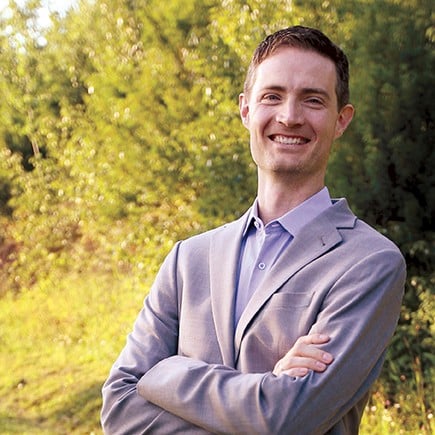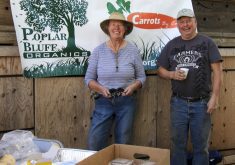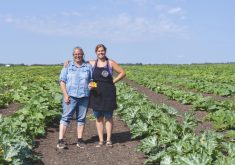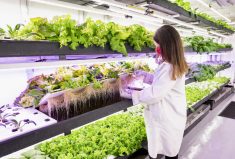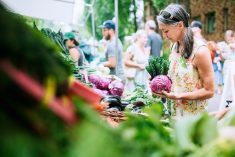For these five adventurous Alberta farmers, a co-op is more than a way to structure operations. It’s more, too, than the camaraderie and the mutual support they get from working together with the same goal in mind, important though that is.
For this group, it’s also about profitability, and about efficiency, and about enhancing their individual businesses.
Yes, it’s a mouthful. And no, this isn’t exactly the first image that pops up in most farmers’ minds when they hear the word “co-op.” But read on. This group of five thinks they’re onto something good, at least for them.
Read Also

Riding the tariff rollercoaster
Farmers are accustomed to roller-coaster years. But the current geopolitical windstorm is something else entirely. On his cattle operation near…
Could it good for you too? That, they say, is for you to decide.
For most farmers, going it alone clearly has its attractions: no business partner to argue with, fewer meetings, less time getting annoyed by the complications of keeping so many balls in the air. Even fewer legal headaches.
Country Guide previously brought you the story of Edgar Farms, near Innisfail, and their impressive and successful commitment to diversification (“You Can’t Do That,” March 3, 2020 issue). It’s a story of how a farm can remain dedicated to beef and grains even while it grows asparagus and other vegetables.
What we singled out for this story is how Innisfail Growers, the co-op that the Edgars helped form, has driven their diversification plan further than they feel they could ever take it on their own.
In a province of sprawling mountains in the west, near desert in the south and east and wild bush in the north, agriculture is everywhere in between. And in the very centre of it all is Innisfail. As far as the eye can see around this town of 8,000 are diversified farms. Grain, cattle, sheep, beef, goat, honeybees, bison, vegetable, fruit, greenhouses and more. Simply put, it’s got a little bit of everything.
Five of those farms — Beck Farms, Edgar Farms, Hillside Greenhouses, The Jungle Farm and Upper Green Farms — work together as Innisfail Growers to supply 23 different farmers markets across the province with a combined 68 products, including asparagus, brussels sprouts, garlic, kohlrabi, leeks, microgreens, onions and pumpkins.

Sure, the crops are hardly million-acre farm mainstays, but it’s the co-op strategy that deserves focus. It’s also important to know that three of the farms have on-farm stores selling year-round, and four have full-size commercial kitchens.
It means Innisfail Growers isn’t your average farm co-op.
Rod and Shelley Bradshaw have an 800-acre grain farm, in addition to 40 acres of carrots, and other vegetables. They have grown carrots since 1986 and hawked at weekend markets out the back of their trusty pickup. However, farming full-time and marketing takes a toll. Eventually, an exhausted Bradshaw family was forced to reconcile the family’s two passions.
“We thought there has to be more to life than working all week and working at the farmers markets all weekend,” Rob Bradshaw says.
It wasn’t until January 1993 when Bradshaw took a trip to England with the now-defunct Alberta Fresh Vegetable Marketing Board and saw the Shropshire Growers near Ely, that he thought there was potential in a co-operative model.
“They had various growers specialized in products,” he says. Quickly, Bradshaw brought the idea back to Alberta and had conversations with his neighbours. Many were interested. In fact, five families said yes to a co-op style structure and they began working together. “The whole idea was that everyone would participate and everybody would share the profits.”
As the next few years came and went, people dropped off, new ones joined, and dropped off. The final membership of Innisfail Growers has been unchanged since 2003 when Carmen and Jose Fuentes joined as Hillside Greenhouses. Prior to that, the structure was static since 1996, when Blaine and wife Leona Staples took over from Leona’s parents at The Jungle Farm.
Today, the number five seems just right.
“I think it’s a workable group,” says Bradshaw. “When we started we had six. It was one of those things that was unworkable. The big thing now is there’s not a lot of crops out there, so everyone specializes. No two people grow the same crop.”
For a family to come on board now, it would likely mean an existing member would have to change their current crop system to accommodate the newbie.
“Somebody needs to give up a crop or they need to come in with a unique crop to have a place in the whole community infrastructure,” says Staples.

Not impossible, but certainly tricky considering the breadth of crops already grown.
The second-newest member, the Staples family (Blaine and Leona), returned to the farm after both working off farm for years. Blaine was schooled as an ag economist while Leona worked a number of years as a district home economist with the provincial government. They initially spent time in the province’s southern region before relocating to Nordegg, Alta., for five years to run Goldeye, a retreat centre founded by the Alberta Community Co-operative Association.
The couple was already interested in the idea of direct marketing and when Leona’s parents decided to retire, they sensed an opportunity on the horizon. The best part was they were returning with loads of ideas around co-ops since Blaine’s university roommate, Rod Bradshaw, had already begun Innisfail Growers.
“[Goldeye] gave us a lot of connection with the whole co-operative moment at that time,” says Staples. “The board of directors at Goldeye were leading people in the co-operatives of the province.” The Stapleses immediately began linking up with Innisfail Growers and began to grow strawberries in 1996 upon their return.
It didn’t take long for word to get out and for them to add zucchinis, cucumbers, pumpkins and sweet corn, among other vegetables.
Working alongside the other families seemed natural for the Stapleses, though their background at Goldeye helped them see ways to beef up the system.
Staples explained some of the members were understandably a bit apprehensive. After all, this was around the time when the Prairie pools were being privatized.
“The co-op name held a bit of a stigma for some,” he says, adding that despite not being an official co-op, Innisfail Growers truly was every bit a co-op. “They had all these wonderful processes and stuff in place as far as managing financial affairs, but really, what Leona and I brought was the knowledge of co-ops. That was really just a formalizing and becoming in compliance… so we had an entity that we could actually be.”
Once set up, their structure was straightforward. Each farm has two votes and a person must be present at a meeting to actually vote. Governance includes a president, vice-president, secretary and treasurer. With 10 members, almost everyone has had a turn at each position. Bradshaw says typically only about half the members get together and meet. All 10 will turn up only if serious matters are at hand.
“More and more we look at more decisions to be made as far as investing and markets,” says Staples. “Anything to do with money is voted upon.”
The group decisions are typically unanimous, but like any board, it’s not all smiles and nods. A few years back, there was talk of hiring a full-time external manager to run everything. However, consensus couldn’t be reached, and the families still felt that individual, internal control was best.
“There’s the odd time someone will vote against something, but it’s never carried forward as a grudge or anything at all,” says Staples. “The organization has been fairly conservative in our growth — slow, steady growth as opposed to very fast growth. Everybody makes small steps to develop the organization and secure its future.”

The group thinks of itself more as a management board, and less policy-driven, like major commodity commissions. They prefer the style, focus and tone to be all about management because Staples and others have seen groups dissolve that didn’t stick to good business practices.
Critically, the group jells well, and one key for this is that they own minimal assets.
“For a while, we had the ultimate divorce strategy,” says Bradshaw. “Because Innisfail Growers didn’t own anything, if you didn’t like it, you just took your toys and went home.”
That mindset has since changed somewhat. The group collectively owns a few items, such as a new point-of-sale cash register for certain markets as well as tables, cloths, props for market days, shelves and coolers, but the idea of owning assets just hasn’t been a priority.
“We don’t buy anything that’s a long-term asset, we prefer to rent,” says Bradshaw. “We have five trucks that go to markets; various members own them.”
Even the money doesn’t stay in the co-op. It is zeroed out every year with no retained earnings left within the co-operative.
“If there’s a profit, it’s divided up per your contribution,” says Bradshaw. “It’s all based on your contribution to the profits, and the reverse. If we ever have a loss, it’s the same.”
The financial system the group devised is as simple as it is in-depth. Created using Microsoft Access by Staples — yes, there are people who legitimately understand this mysterious program — the system has been the financial anchor that has kept the co-op on top of just about every single detail you could imagine. Prior to the database, all information was recorded with pencil on paper.
Created from scratch, the database showed two things. The group sold a lot. They also didn’t have much of a capital cushion to go from market to market.
Complementing the database, Bradshaw created a simple, yet effective system to help push the co-operative forward and rise above the ranks of mom-and-pop shops and into a bona fide business. To that end, a 65-35 per cent ratio was created. The 65 is paid out weekly as earnings on a farm’s sales. Meanwhile, the 35 stays within the co-op and covers off all annual expenses. What remains of the 35 at year-end is paid out to members, as is characteristic of a co-op.
With everything on consignment, the Innisfail Growers are responsible for all their product until it’s sold.
“There’s been a lot of people that have tried to emulate us, but they’re not rigorous enough,” says Staples. “A trap of similar organizations is that a co-op will just buy all the stuff, I’ll take my cheque and wash my hands of it. If we ship a bunch, and they’re not sold, it’s still our product and it’s up to us to move it to another market or take them home and dispose of them if they’re not sufficient quality.”
That same 65-35 per cent ratio is applied at each market through the group’s database, too. Every single market must be earning at least 35 per cent revenue to break even. There’s no water-carrying here.
“Say [that market] uses 40 per cent of its revenue, it’s considered to be losing money,” says Staples. “All those numbers are reviewed every week so we know if a market has been losing, losing, losing, in spite of people pushing that we come to that market. We say, ‘no, we’re not selling enough product to make it pay.’”
It’s a testament to how professional the group has become over nearly three decades in business together.
“This isn’t a hobby,” says Elna Edgar, whose beef and asparagus operation was profiled in Country Guide earlier this month. “This has to be a business if it’s going to be sustainable and viable long-term. You have to know your costs, every penny. You have to amortize every cost. We knew as business people that’s what we would need. I see that as being a no-brainer.”
The group has walked away from underperforming markets that perhaps at one time they would have stuck with because they now know their operating costs, expenses and margins — and aren’t willing to budge.
“If the markets aren’t profitable, we shut them down,” agrees Staples.
The database, which has since been expanded and upgraded can tell the Innisfail Growers more than ever. Members can track and measure year-over-year sales at every market and even punch in weather data, so a historical review will give insights into why a day at market may not have been particularly fruitful.
To ensure accuracy and accountability, the group has established a straightforward and simple system.
When an employee finishes a day at market, they enter an invoice and a market sheet is generated. From there, inventory is ready to be double-checked against what was loaded onto the truck and later sold. The cash box must balance against the amount of product sold as well.
Once all inventory is checked and double-checked against the day’s sales, it’s all put into the database for good. From there, a third-party with a non-vested interest, balances the cash against the remaining inventory when the truck returns. Last, a bookkeeper issues any and all cheques that need to be written.
In the near future, the group is looking at more additions to the year-round market, including a second location at the ever-popular Calgary Farmers’ Market.
They’re also thinking of their families. A number of the originals have already hit senior status, and Staples speculates all the Innisfail Growers will look a lot younger in the next decade. “I think there’s going to be a complete generational change over the next 10 years,” he says. “The next steps are up to the children.”
Indeed, a number of those children are already involved. The Bradshaws’ two sons are already engaged by working at markets and delivering goods. The Buyks of Upper Green are already into a second generation with Hanno and Megan Buyk. At Edgar Farms, daughter Keri Graham and husband Randy have returned to the farm and are solidly in the mix. The Stapleses’ three sons have all expressed interest, although no future plans have been solidified as of yet. The Fuentes’ of Hillside Greenhouses are the youngest of the bunch and may not need to have succession talks for another 20 years, but they do have three young kids, should the conversation arise.
“I’d like to see it go forward,” says Staples of Innisfail Growers’ future. “But really, Innisfail Growers exists because we are a group of people who do get along and enjoy each other. We’ve built something that’s given us profits. If something could change in the marketplace and spell the demise of Innisfail Growers, we’ll stay friends whether we are growers or not.”
The co-operative has given the group something to look back on and to be proud of. It makes Staples believe the future is bright.
“It’s very much a business vehicle and I think that’s why it’s been so successful,” says Staples.
“We’ve been able to look at things from a business perspective rather than an emotional perspective.”
More than that, he reminds fellow farmers that good ideas can come from anyone, even if they contribute the smallest financial amount, making a co-op the perfect home.
Bradshaw sees strength in an attitude that has always been “we” not “me.”
“I believe that a team effort will get you a lot farther,” he says. “I’d rather have a small piece of something than all of nothing.”

